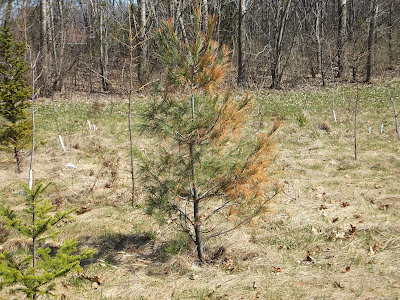
The pines from the 2009 planting on the south side of the berm all have significant winter damage. Winter damage is where the freezing and thawing over the winter damages the needles of evergreens. It typically occurs (as in the above picture) on the south western side of the tree where the afternoon winter sun is strongest. The sun warms up the needle enough for it to come back to life. It opens its stomata to breath in some air to start photosynthesis but in so doing it loses some moisture that is not replenished from the still frozen roots. The winter winds dry out the needle and the ends of the needles turn brown. The pines planted on the north side of the berm have very little winter damage though as they get very little winter sun.
Salt from the road is also a potential desiccant that can damage evergreens. These trees certainly have to put up with a bit of spray from Hunt Club Road that could be a contributing factor to the winter damage, but the pines are about 100m from the road and I can tell from the discolouration of the late winter snow that the road grime mostly stays closer to the road.(more information on browning of evergreens)
In the above picture it is interesting to note that you can see from the spacing between the branches on the trunk that it took two full years for the tree to recover from the transplantation. It grew even less in 2010, the year after transplantation than it did in 2009 the year it was transplanted.
What happens to these branches - do they just die or do the needles get replaced?
ReplyDeleteOn evergreens the die-back goes from tip of the needles back towards the buds and then the branch. The buds on most of these branches are still viable and there will be new growth. The brown needles will fall off but the branch survives.
Delete